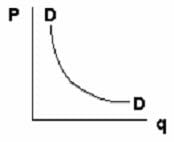Exam Details
Exam Code
:BUSINESS-ENVIRONMENT-AND-CONCEPTSExam Name
:Certified Public Accountant (Business Environment amd Concepts)Certification
:Test Prep CertificationsVendor
:Test PrepTotal Questions
:530 Q&AsLast Updated
:Apr 11, 2025
Test Prep Test Prep Certifications BUSINESS-ENVIRONMENT-AND-CONCEPTS Questions & Answers
-
Question 301:
An increase in the quantity demanded for a product would be associated with a(n):
A. Increase in the price of a complementary product.
B. Increase in average household income.
C. Decrease in the price of that product.
D. Decrease in the price of a substitute product.
-
Question 302:
In which stage of supply chain management will integration move external to the firm to involve those outside the firm who are able to work as a unified team in an attempt to obtain slow, profitable growth?
A. Cross-functional teams.
B. Integrated enterprise.
C. Extended supply chain.
D. Supply chain communities.
-
Question 303:
In which stage of supply chain management will management move away from simple consolidation of its operations to an internally-integrated supply chain, which all work together towards the main business issue of the cost of customer service?
A. Cross-functional teams.
B. Integrated enterprise.
C. Extended supply chain.
D. Supply chain communities.
-
Question 304:
Considering the SCOR Model of supply chain operations, which of the following key management processes does collecting and processing vendor payments fall into?
A. Plan.
B. Source.
C. Make.
D. Deliver.
-
Question 305:
Considering the SCOR Model of supply chain operations, which of the following key management processes does implementing changes in engineering fall into?
A. Plan.
B. Source.
C. Make.
D. Deliver.
-
Question 306:
Considering the SCOR Model of supply chain operations, which of the following key management processes does assessing the ability of the suppliers to supply resources fall into?
A. Plan.
B. Source.
C. Make.
D. Deliver.
-
Question 307:
Considering the SCOR Model of supply chain operations, which of the following key management processes does managing accounts receivable and collections from customers fall into?
A. Plan.
B. Source.
C. Make.
D. Deliver.
-
Question 308:
Which of the following is not correct regarding best cost provider strategies?
A. The overall lowest cost in the industry is not a viable option in best cost strategies because the firm could not compete profit-wise with its differentiation strategy component.
B. When generic products are not acceptable to buyers, yet they still remain price sensitive to the value they are receiving for their money, the best cost strategy may work well.
C. The best cost strategy is a combination of the benefits of the cost leadership and differentiation strategies.
D. The best cost strategy strives to have the firm evaluate and change its value chain such that it can achieve the highest cost among its closest competitors with a quality differentiated product in an effort to obtain the highest profits.
-
Question 309:
When do cost leadership strategies fail?
A. Buyers have large amounts of bargaining power in the market.
B. Heavy price competition exists in the market.
C. Buyers become less price sensitive and start to have brand loyalty.
D. New entry firms are able to influence buyers to switch to their product by cutting the price of their product for a period of time in an effort to gain market share and increase profits.
-
Question 310:
Which of the following is not considered a factor that increases the bargaining power of the customer?
A. Much information is available to the customer to compare and contrast features of all products on the market.
B. One group of customers makes up a large volume of the firm's business.
C. Buyers have low switching costs of changing products.
D. The firm is unable to change suppliers easily.
Related Exams:
AACD
American Academy of Cosmetic DentistryACLS
Advanced Cardiac Life SupportASSET
ASSET Short Placement Tests Developed by ACTASSET-TEST
ASSET Short Placement Tests Developed by ACTBUSINESS-ENVIRONMENT-AND-CONCEPTS
Certified Public Accountant (Business Environment amd Concepts)CBEST-SECTION-1
California Basic Educational Skills Test - MathCBEST-SECTION-2
California Basic Educational Skills Test - ReadingCCE-CCC
Certified Cost Consultant / Cost Engineer (AACE International)CGFM
Certified Government Financial ManagerCGFNS
Commission on Graduates of Foreign Nursing Schools
Tips on How to Prepare for the Exams
Nowadays, the certification exams become more and more important and required by more and more enterprises when applying for a job. But how to prepare for the exam effectively? How to prepare for the exam in a short time with less efforts? How to get a ideal result and how to find the most reliable resources? Here on Vcedump.com, you will find all the answers. Vcedump.com provide not only Test Prep exam questions, answers and explanations but also complete assistance on your exam preparation and certification application. If you are confused on your BUSINESS-ENVIRONMENT-AND-CONCEPTS exam preparations and Test Prep certification application, do not hesitate to visit our Vcedump.com to find your solutions here.
